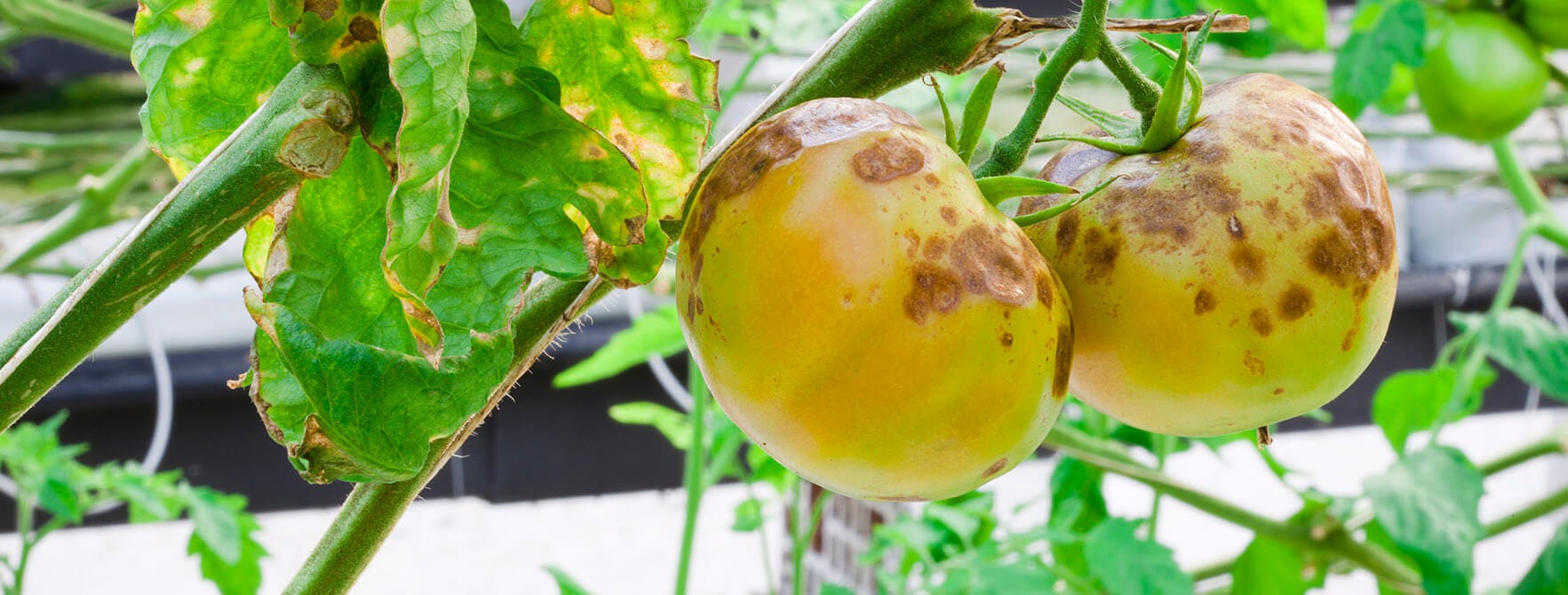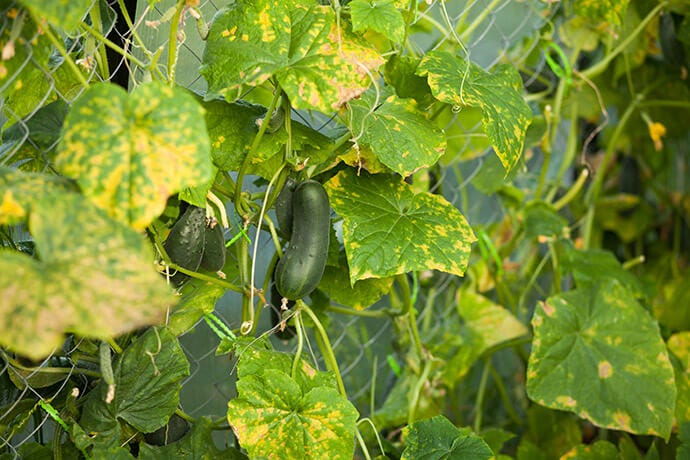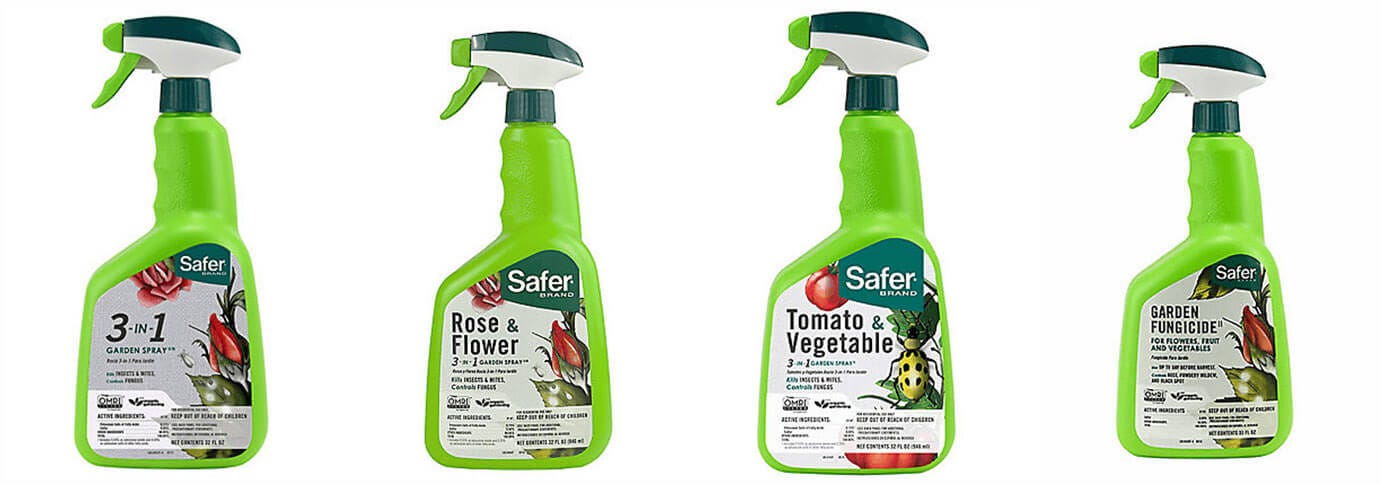
Common Plant Diseases & Symptoms

Blight
- What – While there are many different types of blight affecting different plant species, blight is a disease that prevents plants’ leaves from producing enough chlorophyll.
- Cause – A variety of bacteria species
- Symptoms – Browning or yellowing of leaves, brown plant tissue, and fruit/bulb, or end rot.
- Susceptible Plants – Flowering plants, ornamentals, fruits, and vegetables
- Best Treatment – Early detection and the use of fungicides

Leaf Spot
- What – Leaf spot is a common name for a group of diseases that affect many different plants. Large clusters of this disease are often called anthracnose or cankers.
- Cause – Fungi or bacteria
- Symptoms – Spots on leaves are typically brown, but can be tan or black. Rings or dark margins around the spots are also common. If left untreated, these spots can eventually grow together to form blotches. Leaves will often turn yellow or drop prematurely.
- Susceptible Plants – Most leaf-bearing plants, especially trees and shrubs
- Best Treatment – Remove all fallen debris from the plant such as leaves. The fungi can remain alive in the dead plant matter and spread from plant to plant. Fungicides are great treatments to pair with this.

Powdery Mildew
- What – Powdery mildew is a white or grey substance that lives on plant leaves. Mildew can appear like dust or dirt and is easily rubbed off. It is most often found on lower leaves but the mildew can infect the entire plant.
- Cause – Fungi
- Symptoms – Stunted growth, distortion of leaves or buds, yellow leaves, tissue death, and premature leaf drop are all common symptoms.
- Susceptible Plants – Most plant species are susceptible, but the most commonly affected are African violets, begonias, lilacs, phlox, and roses.
- Best Treatment – Fungicides, ensure proper soil drainage, compost, and keep leaves dry.

Rust
- What – Over 5,000 species of this fungal disease can infect your plants. It typically appears as a brownish yellow or bright orange spot. These spots are filled with a powdery substance which contains spores that travel through the air to infect other plants.
- Cause – Fungi
- Symptoms – Defoliation and stunted growth are the most common symptoms of this disease as well as the appearance of rust-like spots.
- Susceptible Plants – Most plants can be infected by this fungi.
- Best Treatment – Prevention is the best defense. Practice good gardening by keeping the soil healthy and well-drained. Fungicides are the only effective way to rid your garden of rust if you do not want to remove the plant entirely.

Root Rot
- What – Excess water and lack of oxygen create the perfect environment for fungi to invade. Ultimately, it will cause the roots of plants to rot and the plant will die shortly after.
- Cause – Fungal invasion from lack of oxygen and poor drainage
- Symptoms – Sudden death of a plant and slow or stunted growth.
- Susceptible Plants – Any indoor or outdoor plant
- Best Treatment – Since the spores can be carried by insects in the soil, a plant suffering from this disease should be removed as soon as possible. Keep soil well-drained to prevent this from occurring again. Once root rot sets in, there is no treatment.

Mosaic Virus
- What – Mosaic viruses infect a wide variety of plants and are characterized by the distinct mottling pattern made on leaves. They are often confused with nutrient deficiencies which makes them much more difficult to diagnose than a fungal infection.
- Cause – A virus infects plants and can be spread by insects that feed on the weeds they overwinter in.
- Symptoms – Yellow green stripes/streaks/spots on leaves, wrinkled or curled leaves, yellowing of leaf veins, stunted growth, reduced crop or flower yields, fruit appears mottled and can develop wart-like areas.
- Susceptible Plants – Most plants can be infected, but the most commonly affected are cucumbers, tomatoes, potatoes, peppers, and tobacco.
- Best Treatment – There are no known cures for this disease. Make sure you remove the plant and dispose of it away from your healthy plants and compost. Treat plants with an organic insecticide to help prevent its spread.

Black Spot
- What – Black spot is an infectious fungal disease that appears as black spots on leaves.
- Cause – Fungi
- Symptoms – Black spots on leaves, yellowing of leaves around spots, and premature leaf drop.
- Susceptible Plants – Most species of roses
- Best Treatment – Keep soil well-drained as this disease thrives in wet conditions. Fungicide can also kill existing outbreaks and help prevent new ones.
Causes of Plant Diseases
There are times when diseases hit and there is only one cause, making them simple to fix and prevent. More often than not, there are several factors involved that can contribute to your plant(s) getting sick or infected. Read on to learn more about what these factors are so you can minimize the chances of inviting disease into your garden.
Living Factors
All you need for a disease to take hold is a susceptible host (a plant), the perfect environment for the disease to thrive, and a pathogen/disease.
- Fungi – Fungi love warm, moist environments. They can be spread by air, water, insects, garden tools, etc. These can usually be treated with a fungicide or the plant can be removed entirely to prevent the disease from spreading.
- Bacteria – Like fungi, bacteria can be spread in many ways and also enjoy warmer climates, but they have been found in widely varying temperatures. Keep your soil as healthy as possible to prevent these invaders and spray plants with a fungicide to get rid of them.
- Viruses – These are the only incurable disease-causing organisms on this list. The best defense against these diseases is prevention. Keep your plants and soil healthy so they are better equipped to fight off disease. After a plant is infected with a virus, remove the plant entirely and dispose of it away from your healthy plants and compost.
Non-Living Factors
- Temperature – Just like your plants, diseases need specific temperatures to thrive. Warmer temperatures in the air and soil are ideal for most diseases to become active.
- Moisture – Nothing in your garden loves moisture quite like fungi. Add in warm temperatures and you’ve got the perfect environment for disease to call your garden home.
- Nutrition – A healthy garden puts up a natural defense against disease. Give your plants the proper nutrients by promoting soil health, keeping pests under control, and providing nutrients from organic fertilizers and other products.
Disease Control Options

Disease happens, even to the most accomplished of gardeners. Knowing how to control the diseases that slip past your defenses can prevent them from spreading. Fungicides are products used to kill fungi and their spores. Always choose an organic fungicide or one that is compliant for use in organic gardening. They contain no harmful chemicals that could potentially harm your garden and oftentimes contain vital nutrients to give your plants a boost.
Take the time to read the labels before you buy a fungicide. Some are optimized to perform better on roses or tomatoes and may not work as well on other plants. Spray your plants either early in the morning or later in the day to prevent burning on your plants. Make sure to reapply after heavy rains to get the best results possible.
Disposing of a Deceased Plant
You did everything you could, but your plant just couldn’t fight off that troublesome disease. Now what? Never leave a diseased plant in your garden. Many diseases can lay dormant for months or even years in the soil if they encounter the right conditions.
To prevent this from happening, remove the plant and its root system. Clean up any leaves or other debris that may have fallen off and throw it all in the garbage. Make sure not to place the diseased plant in your compost pile or near your healthy plants to prevent possible contamination. Treat your plants with a fungicide or insecticide if your disease was fungus-based or spread by insects.
Prevention

Defense is everything. Keep the environment in your garden perfect for your plants, not disease, and you will automatically see a reduction of disease. The healthier your garden, the higher its defenses will be. Take a look below to see many different ways you can contribute to the health of your garden while also preventing disease from taking over.
- Healthy Soil – Plants are as healthy as the soil they live in. Encourage beneficial microbes. They will keep the soil nutrient dense for your plants and help prevent harmful bacteria from invading.
- Make Cleanup a Priority – Cleaning up leaves, twigs, etc. can make a huge difference. These items, while small, provide the perfect place for insects to hide. Keep shelter for harmful bugs to a minimum to prevent the spread of disease.
- Rotate Crops – If you plant the same crops or flowers year after year and always see the same diseases pop up, try something new. Plant a different species that the disease you always see won’t be able to infect.
- Remove Infected Plants – Once you notice a disease on one plant, get it out of there! Fungal diseases spread rapidly through a variety of methods, so it’s best to remove the problem entirely before it can get worse. Remember that it’s easier to replace one plant than it is your entire garden.
- Diversify – Just like your investment accounts, it’s good to diversify what and where you plant in your garden. Plant lots of species in one area, but be careful not to overcrowd. Make sure there is enough space for air to flow freely and prevent the buildup of moisture. If you know you usually get one type of disease on your roses, don’t plant them all in one area.
- Timed Planting – Insects usually make their appearance around the same time each year. Plant your garden so your plants come up after the worst of their invasion is over. Make sure you still have some flowering plants in your garden to keep the pollinators healthy!
- Resistant Varieties – Many plants, such as roses, have disease-resistant varieties. All this means is certain plant species naturally have more defenses against certain diseases than others. Try to plant those types if you have the same disease haunting your garden year after year.
- Promote Good Drainage – Compacted soil that remains wet for most of the day is an open invitation for fungi and disease. Keep your soil well-drained by tilling or landscaping to prevent conditions diseases can easily thrive in.
- Be Sanitary/Clean Tools – Think of your garden tools more along the lines of surgical instruments for your garden. You wouldn’t want someone operating on you with dirty tools that may spread disease, so make sure not to do the same to your garden. Sanitize or clean your tools every time you finish with them or come into contact with a diseased plant to prevent spreading disease or fungi.
- Practice Smart Watering – It might not seem obvious, but there are actually right and wrong ways to water your garden. Plants can absorb nutrients through their leaves so watering the entire plant isn’t necessarily a bad thing. However, wet foliage can promote conditions that invite fungi. Water plants in the morning to give them enough time to dry and try to water the soil not the plant.
- Protect Against Bugs – Whether it’s an organic insecticide, row covers, diatomaceous earth, or neem oil, your plants need protection from harmful insects. Many insects produce honeydew, a sticky substance that attracts more insects and fungi. Insects also weaken plants as they eat them and create more openings for a disease to enter a plant. Therefore it is essential to keep them away, so they can fight disease to the best of their abilities

